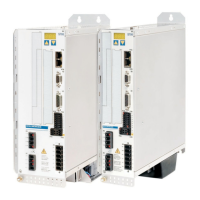S748-772 Instructions Manual | 9 Electrical Installation
9.2 Guide to electrical installation
Correct wiring is the basis for reliable functioning of the servo system. Route power and con-
trol cables separately. We recommend a distance of at least 200 mm. This improves the
interference immunity. If a motor power cable is used that includes cores for brake control,
the brake control cores must be separately shielded. Ground the shielding at both ends.
Ground all shielding with large areas (low impedance), with metalized connector housings or
shield connection clamps wherever possible. Notes on connection techniques (➜ # 62).
Feedback lines may not be extended, since thereby the shielding would be interrupted and
the signal processing could be disturbed. Lines between servo amplifiers and filter or
external brake resistor must be shielded. Install all power cables with an adequate cross-
section, as per IEC 60204 to reach max. cable length (➜ # 63).
The following notes should assist you to carry out the electrical installation in a sensible
sequence, without overlooking anything important.
Cable
selection
Select cables according to EN 60204, (➜ # 33).
Grounding
Shielding
EMC-compliant (EMI) shielding and grounding, (➜ # 67).
Earth (ground) the mounting plate, motor housing and CNC-GND of the
controls (➜ # 62).
Wiring
Route power leads and control cables separately. Wire the BTB/RTO contact
in series into the emergency off circuit of the system.
1. Connect the digital control inputs to the servo amplifier.
2. Connect up AGND (also if fieldbuses are used).
3. Connect the analog setpoint, if required.
4. Connect up the feedback unit (resolver and/or encoder).
5. Connect the encoder emulation, if required.
6. Connect the expansion card (➜ # 126).
7. Connect the motor cables, connect shielding at both ends.
8. Connect motor-holding brake, connect shielding at both ends.
9. Connect the external brake resistor (with fusing).
10. Connect aux. supply (for max. permissible voltage values (➜ # 31)).
11. Connect main power supply (for max. permissible voltage values (➜ #
31), hints for use of residual-current circuit breakers (FI) (➜ # 52)
12. Connect PC (➜ # 104).
Final check
Final check of the implementation of the wiring, according to the wiring dia-
grams which have been used.
60 Kollmorgen | kdn.kollmorgen.com | July 2019

